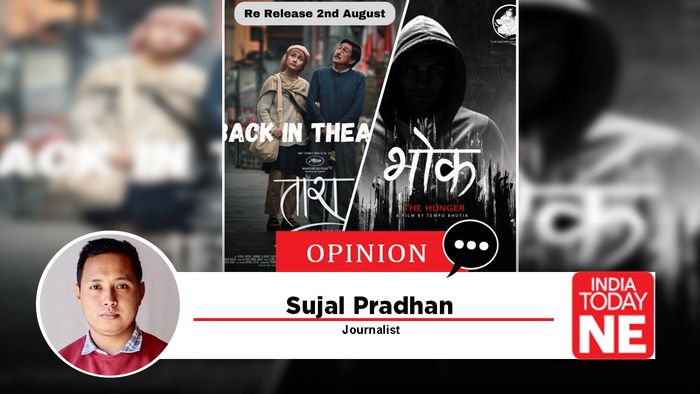Sikkim’s cinematic renaissance: From local talent to global recognition
Sikkim, a small state in Northeast India, is making waves in the global film industry. Local filmmakers are receiving international acclaim, reflecting the state's cultural richness and supportive environment.

- Aug 12, 2024,
- Updated Aug 12, 2024, 11:25 AM IST
Sikkim, a small yet vibrant state in Northeast India is making waves in the global film industry. With a population of just around 5 lakhs, the state’s filmmakers are achieving international acclaim. This remarkable journey reflects the cultural richness of Sikkim and the supportive environment fostered by the Sikkim Krantikari Morcha (SKM) government, which is actively promoting local filmmakers.
One of the most significant milestones in Sikkim's cinematic journey is the selection of Samten Bhutia’s feature film, Tara: The Lost Star, for screening at the Marché Du Film, the official film market of the Cannes International Film Festival. This prestigious platform provides unparalleled exposure, showcasing the film to global distributors, producers, and critics.
Tara: The Lost Star is a Nepali-language social drama that delves into the beliefs and vibrant culture of the Himalayas. Featuring local artists such as Shyama Shree Sherpa and Kiran Dahal, the film's compelling narrative and authentic portrayal of Sikkimese life have garnered widespread acclaim. The selection of this film for Cannes not only highlights the talent of Sikkimese filmmakers but also underscores the growing global recognition of regional cinema.
In a social media post, Sikkim Chief Minister Prem Singh Tamang congratulated the team behind Tara: The Lost Star and commended their dedication and vision, emphasising how this achievement showcases Sikkim's rich cultural narratives to a global audience. The chief minister's recognition of this milestone reflects the state's commitment to nurturing its artistic talents.
Another noteworthy achievement for Sikkim's film industry is Tempo Bhutia's short film Bhok, which won the Best Short Film award in the horror/suspense category at the Mokkho International Film Festival in Kolkata. Bhok, featuring a gripping narrative and exceptional performances, captivated audiences with its intense storytelling and chilling atmosphere.
Bhutia's success at the festival is a significant milestone for him and the Sikkimese filmmaking community. His gratitude and excitement upon receiving the award reflect the hard work and passion driving Sikkim's emerging filmmakers. As Bhutia continues to make his mark, his achievements inspire a new generation of Sikkimese artists to pursue their cinematic dreams.
The SKM government has been instrumental in fostering a supportive environment for filmmakers. Recognising the potential of the film industry to promote cultural heritage and generate economic benefits, the government has implemented several initiatives to encourage local talent. One such initiative is the Sikkim Kalakar Bharosa Sammelan, a monumental event endorsed by the government to celebrate and support artists across the state.
Held in February 27 and 28 in Gangtok, the Sikkim Kalakar Bharosa Sammelan brought together artists from various fields to interact directly with the state's leadership. Chief Minister Prem Singh Tamang engaged with the artists, listening to their concerns and aspirations firsthand.
Central to the agenda was the formulation of a comprehensive policy to address the challenges faced by Sikkim's artists, ranging from recognition and support to the implementation of regulations safeguarding their interests.
In addition to supporting filmmakers, the SKM government has introduced initiatives to honour outstanding contributions in various artistic genres. The Sikkim Akademi Award, an annual award established by the Sikkim Akademi under the State Culture Department, aims to recognise excellence in music, literature, and visual arts. The inaugural recipient of this award is young painter Sewon Rai, who has made significant contributions to the art world with his exceptional talent and dedication.
The state's dedication to preserving and promoting cultural heritage is further exemplified by the recognition of traditional crafts. Renowned bamboo craftsman Jorden Lepcha was conferred with the prestigious Padma Shri award for his artistic excellence. Lepcha's journey from the village of Rubeyam Ram to receiving one of India's highest civilian honors is a story of perseverance and passion.
Lepcha's work in preserving the ancient art of bamboo crafting, particularly the creation of Lepcha hats known as Thyaktuks, has not only earned him personal accolades but also empowered his community. By conducting training sessions for aspiring artisans, Lepcha has ensured that this traditional craft continues to thrive.
Sikkim’s cinematic journey can be traced back to Satyajit Ray’s 1971 documentary Sikkim. Commissioned by the Chogyal of Sikkim, the documentary offered a poetic and optimistic portrayal of the state. Although it was banned by the Indian government when Sikkim merged with India in 1975, the film was eventually restored and screened in 2010. Ray’s documentary remains a poignant reminder of Sikkim’s rich cultural heritage and the timeless appeal of its narratives.
As Sikkim's film industry continues to grow, the state's unique cultural narratives and breathtaking landscapes offer a rich tapestry for filmmakers to explore. The global recognition garnered by films like Tara: The Lost Star and Bhok highlights the potential of Sikkimese cinema to captivate audiences worldwide.
The SKM government's proactive support and initiatives have created a nurturing environment for artists, enabling them to achieve their full potential. By celebrating artistic excellence and preserving cultural heritage, Sikkim is not only enriching its own cultural landscape but also contributing to the global tapestry of cinema.
As Sikkimese cinema continues to shine on the global stage, it serves as an inspiration for small states and regions worldwide, demonstrating that with passion, support, and vision, even the smallest communities can achieve greatness.